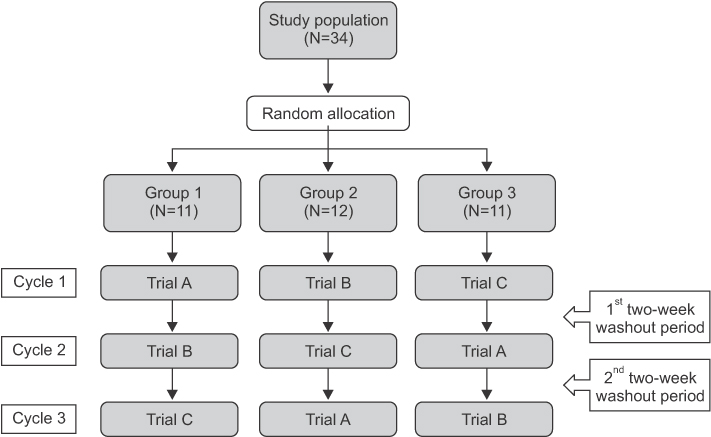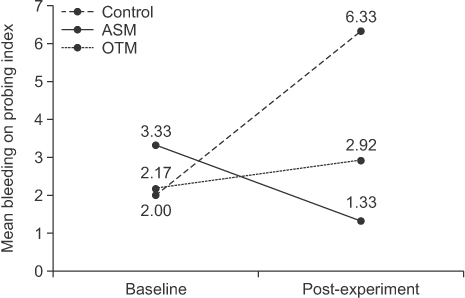J Korean Acad Oral Health.
2017 Sep;41(3):181-187. 10.11149/jkaoh.2017.41.3.181.
Comparative effects of aqueous single-phase and oil-water two-phase mouthrinses containing bamboo salt, magnolia bark and Centella asiatica extracts on reducing gingivitis: a randomized clinical trial
- Affiliations
-
- 1Department of Preventive and Social Dentistry, School of Dentistry, Seoul National University, Seoul, Korea. jjbh@snu.ac.kr
- KMID: 2392436
- DOI: http://doi.org/10.11149/jkaoh.2017.41.3.181
Abstract
OBJECTIVES
The aim of this study was to assess the antiplaque and antigingivitis effectiveness of aqueous single-phase and oil-water two-phase mouthrinses, containing bamboo salt, magnolia bark, and Centella asiatica extracts, in Korean adults.
METHODS
In this double-blinded clinical trial, a total of thirty-four participants aged over 19 years were randomly allocated to three experimental groups: 1) control group; 2) aqueous single-phase mouthrinse (ASM) group, and; 3) oil-water two-phase mouthrinse (OTM) group. The experimental mouthrinses all contained sodium fluoride, and the ASM and OTM contained additional ingredients of bamboo salt, magnolia bark, and Centella asiatica extracts. For the OTM, 50% essential oil was added to create an oil-water two-phase mouthrinse. A two-week randomized crossover design with a two-week washout period was applied. Following a complete dental prophylaxis, participants were instructed to use the prescribed mouthrinse twice daily for two weeks as an adjunct to their usual mechanical oral hygiene procedures. Pre- and post-experiment clinical examinations were performed to measure the plaque index (PI) and bleeding on probing (BOP) for the full mouth. Paired t-test was applied to compare the intergroup differences for all clinical variables.
RESULTS
Compared to the control group, ASM showed a significantly reduced BOP (P<0.05). However, there was no statistically significant difference in the effects of the three mouthrinses on reducing the PI.
CONCLUSIONS
The results of this study indicate that the use of an aqueous, single-phase mouthrinse containing bamboo salt, magnolia bark and Centella asiatica extracts could help alleviate gingivitis.
Keyword
MeSH Terms
Figure
Reference
-
1. Mandel ID. Chemotherapeutic agents for controlling plaque and gingivitis. J Clin Periodontol. 1988; 15:488–498.
Article2. Therapeutics CoD. Guidelines for acceptance of chemotherapeutic products for the control of supragingival dental plaque and gingivitis. J Am Dent Assoc. 1986; 112:529–532.3. Lang NP, Schätzle MA, Löe H. Gingivitis as a risk factor in periodontal disease. J Clin Periodontol. 2009; 36:3–8.
Article4. Van der Weijden G, Hioe K. A systematic review of the effectiveness of self-performed mechanical plaque removal in adults with gingivitis using a manual toothbrush. J Clin Periodontol. 2005; 32:214–228.
Article5. Jenkins S, Addy M, Newcombe R. Comparison of two commercially available chlorhexidine mouthrinses: II. Effects on plaque reformation, gingivitis, and tooth staining. Clin Prev Dent. 1989; 11:12–16.6. Rule KL, Ebbett VR, Vikesland PJ. Formation of chloroform and chlorinated organics by free-chlorine-mediated oxidation of triclosan. Environ Sci Technol. 2005; 39:3176–3185.
Article7. Visweswari G, Prasad KS, Chetan PS, Lokanathan V, Rajendra W. Evaluation of the anticonvulsant effect of Centella asiatica (gotu kola) in pentylenetetrazole-induced seizures with respect to cholinergic neurotransmission. Epilepsy Behav. 2010; 17:332–335.
Article8. Sushma T, Sangeeta G, Gambhir I. Centella asiatica: a concise drug review with probable clinical uses. J Stress Physio Biochem. 2011; 7:38–44.9. Palombo EA. Traditional medicinal plant extracts and natural products with activity against oral bacteria: potential application in the prevention and treatment of oral diseases. Evid Based Complement Alternat Med. 2011; 2011:15.
Article10. Zhou J, Yan XG. Handbook of the traditional chinese medicines. Beijing, China: Chemical Industry Pub;2004.11. Bae EA, Han MJ, Kim NJ, Kim DH. Anti-helicobacter pylori activity of herbal medicines. Biol Pharm Bull. 1998; 21:990–992.
Article12. Park J, Lee J, Jung E, Park Y, Kim K, Park B, et al. In vitro antibacterial and anti-inflammatory effects of honokiol and magnolol against Propionibacterium sp. Eur J Pharmacol. 2004; 496:189–195.
Article13. Ho KY, Tsai CC, Chen CP, Huang JS, Lin CC. Antimicrobial activity of honokiol and magnolol isolated from Centella asiatica. Phytother Res. 2001; 15:139–141.14. Shin HY, Lee EH, Kim CY, Shin TY, Kim SD, Song YS, et al. Antiinflammatory activity of Korean folk medicine purple bamboo salt. Immunopharmacol Immunotoxicol. 2003; 25:377–384.
Article15. Ma DS, Jin BH, Park DY, Kim JB, Paik DI, Moon HS. The reducing effects on gingivitis and dental caries of toothpastes containing monofluorophosphate, bamboo salt, alantoin chlorohydroxy aluminum and dl - α tocopheral acetate. J Korean Acad Oral Health. 1994; 18:554–563.16. Kim CY, Chung SC, Sohn WS. Comparison of the anti-plaque and anti-inflammatory effect of the dentifrices containing NaCl and bamboo salt. J Korean Acad Oral Health. 1991; 15:269–280.17. Kim JB, Paik DI, Moon HS, Jin BH, Park DY. A study on the effects of cetylpyridinium chloride and bamboo salt containing mouth rinse on the number of Streptococcus mutans and plaque index. J Korean Acad Oral Health. 1993; 17:176–187.18. Araujo MWB, Charles CA, Weinstein RB, McGuire JA, Parikh-Das AM, Du Q, et al. Meta-analysis of the effect of an essential oil–containing mouthrinse on gingivitis and plaque. J Am Dent Assoc. 2015; 146:610–622.
Article19. Kozlovsky A, Goldberg S, Natour I, Rogatky-Gat A, Gelernter I, Rosenberg M. Efficacy of a 2-phase oil: water mouthrinse in controlling oral malodor, gingivitis, and plaque. J Periodontol. 1996; 67:577–582.
Article20. Turesky S, Gilmore ND, Glickman I. Reduced plaque formation by the chloromethyl analogue of victamine C. J Periodontol. 1970; 41:41–43.
Article21. Van Der Weijden F, Slot DE. Oral hygiene in the prevention of periodontal diseases: the evidence. Periodontol 2000. 2011; 55:104–123.
Article22. Axelsson P, Nyström B, Lindhe J. The long-term effect of a plaque control program on tooth mortality, caries and periodontal disease in adults. J Clin Periodontol. 2004; 31:749–757.
Article23. Barnett ML. The rationale for the daily use of an antimicrobial mouthrinse. J Am Dent Assoc. 2006; 137:S16–S21.
Article24. Slot D, Wiggelinkhuizen L, Rosema N, Van der Weijden G. The efficacy of manual toothbrushes following a brushing exercise: a systematic review. Int J Dent Hyg. 2012; 10:187–197.
Article25. Page RC. Gingivitis. J Clin Periodontol. 1986; 13:345–359.
Article26. Claffey , et al. Diagnostic predictability of scores of plaque, bleeding, suppuration and probing depth for probing attachment loss. J Clin Periodontol. 1990; 17:108–114.
Article27. Greenberg M, Urnezis P, Tian M. Compressed mints and chewing gum containing magnolia bark extract are effective against bacteria responsible for oral malodor. J Agric Food Chem. 2007; 55:9465–9469.
Article28. Maquart FX, Bellon G, Gillery P, Wegrowski Y, Borel JP. Stimulation of collagen synthesis in fibroblast cultures by a triterpene extracted from Centella asiatica. Connect Tissue Res. 1990; 24:107–120.
Article29. Amith H, Ankola AV, Nagesh L. Effect of oil pulling on plaque and gingivitis. J Oral Health Comm Dent. 2007; 1:12–18.
Article30. Cowan MM. Plant products as antimicrobial agents. Clin Microbiol Rev. 1999; 12:564–582.
Article
- Full Text Links
- Actions
-
Cited
- CITED
-
- Close
- Share
- Similar articles
-
- Centella asiatica enhances neurogenesis and protects neuronal cells against H2O2-induced oxidative injury
- Antifungal Activity of Methanolic of Centella asiatica and Andrographis panicuiata
- First Report of Septoria centellae Associated with Leaf Spot of Centella asiatica in Korea
- Effect of Mouthrinses prepared by Sterilized Water-Generating Device on the Control of Periodontal Disease
- Biological Activities and Stability of a Standardized Pentacyclic Triterpene Enriched Centella asiatica Extract



